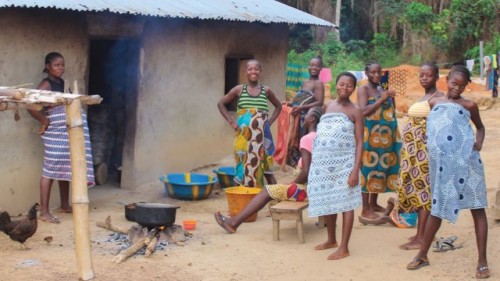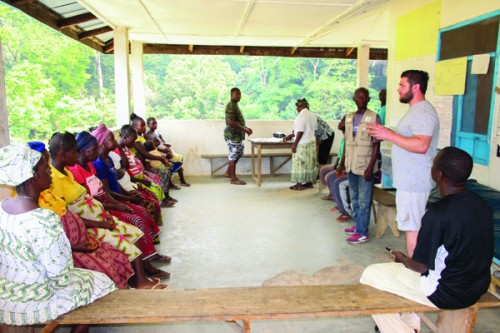The Road to Maternal Health
Read the original story in the Summer 2018 edition of Panacea.
Imagine labor begins and you are at home, miles away from a health facility.
Now imagine a complication. Rather than calling 911, your attendant has to send a neighbor to find your husband who is working in a field 30 minutes away, entirely unaware that you’ve gone into labor. She needs his help and permission to move you to the nearest clinic.
Upon returning to your home, your husband helps the attendant secure you in a hammock-like carrier. He handles one end and the neighbor handles the other. It takes them an hour to walk four miles along a bumpy trail to the nearest clinic.
You make it to the clinic only to be told you need a cesarean section, but the clinic staff has neither the skills nor the equipment required for the surgery.
Maternal health in Liberia
 This is the reality for thousands of women in Africa’s west coast nation of Liberia, where the vast majority of births in rural areas take place outside of health care facilities. Midwife Jody Lori, Ph.D., FACNM, FAAN, (BSN ‘80, MS ‘92) has witnessed this scenario countless times.
This is the reality for thousands of women in Africa’s west coast nation of Liberia, where the vast majority of births in rural areas take place outside of health care facilities. Midwife Jody Lori, Ph.D., FACNM, FAAN, (BSN ‘80, MS ‘92) has witnessed this scenario countless times.
Lori, who is now the associate dean for the Office of Global Affairs at the University of Michigan School of Nursing (UMSN), began traveling to Liberia in 2006 to train nurses, midwives and traditional birth attendants in early problem identification for women in labor. She quickly realized a new approach was needed to reduce maternal and newborn deaths.
“Otherwise, [the woman] would have to walk home in four hours,” explained Lori. “This lets her stay longer, at least overnight, for those critical hours after delivery.”
Dual devastation
Lori and her team helped build several MWHs in Liberia over the next few years as a small but mighty piece of a health care system in desperate need of help after two major setbacks over the past 30 years. The first was a civil war that began in 1989 and didn’t end until 2003. Many physical structures, including clinics, hospitals, schools and roads, were destroyed or abandoned. Health care workers fled the nation in droves.
“After the war, there were only 24 doctors and about 400 nurses for the entire country of four million people,” said Lori. “No one had the opportunity to upgrade their skills during that time. Everything was needed. There was also a lot of mistrust between communities.”
After peace was re-established, Liberia began to rebuild with assistance from international organizations. The country made considerable progress.
Then Ebola hit.
Ebola
“We were about to travel with a group of students to work in a rural hospital,” said Lori. “It hadn’t even hit the papers yet when a friend who lives in Liberia emailed me. It was a Tuesday. We were supposed to leave on Thursday. We had to cancel.” For Lori, it was much more than a canceled trip.
“Four nurses from that hospital died,” she said quietly. “They were nurses that I knew. It was so sad.”
Nearly 5,000 people in Liberia, including hundreds of health care workers, died from Ebola in 2014–16. Once again, the health care system was ravaged.
“They had just started to rebuild,” said Lori. “It was devastating. Everyone was traumatized all over again.”
Forging ahead
Lori’s commitment to Liberia didn’t waver (and still hasn’t). She knew other schools, charities and non-governmental organizations were also building MWHs, so she decided it was time for a review. With a grant from the Bill and Melinda Gates Foundation, she and her fellow researchers set out to learn how often MWHs were being used, which strategies worked and which didn’t. When she began taking inventory, Lori was shocked.
“We thought there were about 25 [MWHs],” she said. “We discovered there were about 150.”
Lori credits efforts to strengthen the country’s health care system, including MWHs, with improving trends in maternal and infant mortality. However, while MWHs are considered a success, not all are being used to their full potential.
“We are finding that the ones that did not engage the community at the beginning are the ones that are faltering,” explained Lori. “It’s so important to engage the community from the start.”
Lori says MWHs are more effective when the community becomes invested.
 “The community will actually make the bricks for the maternity waiting home and haul the sand needed for construction,” she said. “Everyone pitches in. They establish a community health group that helps with the planning and the day-to-day operations. It’s pretty incredible to see.”
“The community will actually make the bricks for the maternity waiting home and haul the sand needed for construction,” she said. “Everyone pitches in. They establish a community health group that helps with the planning and the day-to-day operations. It’s pretty incredible to see.”
Lori and her team are also using GPS to map MWH locations. This project was part of a recent spring 2018 trip.
“We met with the new minister of health on her second day of work,” said Lori. “She’s very excited about the homes. The health ministry is interested in the data we’re gathering to examine how a standardized model can be built into their health system. They would like to have a core model for Liberia that the ministry can say, ‘If you’re going to do this, this is what works.’”
For Lori, the commitment to strengthening Liberia’s health system comes not from devastation but from hope.
“I see little glimmers of progress each time I go because things are a little better than what they were the time before. There are young people in Liberia that know nothing different than war and Ebola because that’s what their lives have been. But there’s a generation that knew what it was like before, and they have been the drivers of this movement to make things better.”





